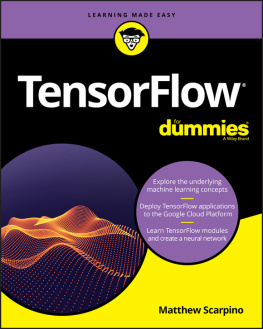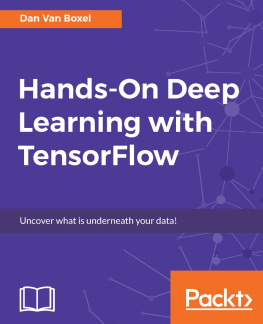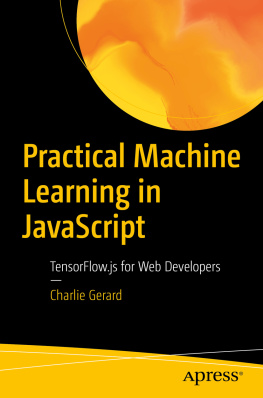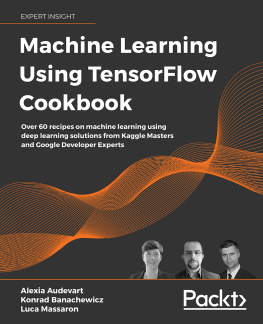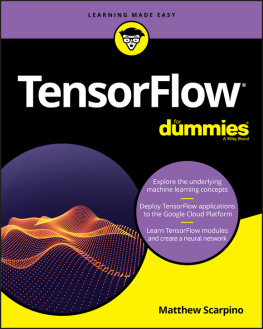

TensorFlow For Dummies
Published by: John Wiley & Sons, Inc., 111 River Street, Hoboken, NJ 07030-5774, www.wiley.com
Copyright 2018 by John Wiley & Sons, Inc., Hoboken, New Jersey
Published simultaneously in Canada
No part of this publication may be reproduced, stored in a retrieval system or transmitted in any form or by any means, electronic, mechanical, photocopying, recording, scanning or otherwise, except as permitted under Sections 107 or 108 of the 1976 United States Copyright Act, without the prior written permission of the Publisher. Requests to the Publisher for permission should be addressed to the Permissions Department, John Wiley & Sons, Inc., 111 River Street, Hoboken, NJ 07030, (201) 748-6011, fax (201) 748-6008, or online at http://www.wiley.com/go/permissions .
Trademarks: Wiley, For Dummies, the Dummies Man logo, Dummies.com, Making Everything Easier, and related trade dress are trademarks or registered trademarks of John Wiley & Sons, Inc. and may not be used without written permission. TensorFlow is a registered trademark of Google, LLC. All other trademarks are the property of their respective owners. John Wiley & Sons, Inc. is not associated with any product or vendor mentioned in this book.
LIMIT OF LIABILITY/DISCLAIMER OF WARRANTY: THE PUBLISHER AND THE AUTHOR MAKE NO REPRESENTATIONS OR WARRANTIES WITH RESPECT TO THE ACCURACY OR COMPLETENESS OF THE CONTENTS OF THIS WORK AND SPECIFICALLY DISCLAIM ALL WARRANTIES, INCLUDING WITHOUT LIMITATION WARRANTIES OF FITNESS FOR A PARTICULAR PURPOSE. NO WARRANTY MAY BE CREATED OR EXTENDED BY SALES OR PROMOTIONAL MATERIALS. THE ADVICE AND STRATEGIES CONTAINED HEREIN MAY NOT BE SUITABLE FOR EVERY SITUATION. THIS WORK IS SOLD WITH THE UNDERSTANDING THAT THE PUBLISHER IS NOT ENGAGED IN RENDERING LEGAL, ACCOUNTING, OR OTHER PROFESSIONAL SERVICES. IF PROFESSIONAL ASSISTANCE IS REQUIRED, THE SERVICES OF A COMPETENT PROFESSIONAL PERSON SHOULD BE SOUGHT. NEITHER THE PUBLISHER NOR THE AUTHOR SHALL BE LIABLE FOR DAMAGES ARISING HEREFROM. THE FACT THAT AN ORGANIZATION OR WEBSITE IS REFERRED TO IN THIS WORK AS A CITATION AND/OR A POTENTIAL SOURCE OF FURTHER INFORMATION DOES NOT MEAN THAT THE AUTHOR OR THE PUBLISHER ENDORSES THE INFORMATION THE ORGANIZATION OR WEBSITE MAY PROVIDE OR RECOMMENDATIONS IT MAY MAKE. FURTHER, READERS SHOULD BE AWARE THAT INTERNET WEBSITES LISTED IN THIS WORK MAY HAVE CHANGED OR DISAPPEARED BETWEEN WHEN THIS WORK WAS WRITTEN AND WHEN IT IS READ.
For general information on our other products and services, please contact our Customer Care Department within the U.S. at 877-762-2974, outside the U.S. at 317-572-3993, or fax 317-572-4002. For technical support, please visit https://hub.wiley.com/community/support/dummies .
Wiley publishes in a variety of print and electronic formats and by print-on-demand. Some material included with standard print versions of this book may not be included in e-books or in print-on-demand. If this book refers to media such as a CD or DVD that is not included in the version you purchased, you may download this material at http://booksupport.wiley.com . For more information about Wiley products, visit www.wiley.com .
Library of Congress Control Number: 2018933981
ISBN 978-1-119-46621-5 (pbk); ISBN 978-1-119-46619-2 (ePub); 978-1-119-46620-8 (ePDF)
TensorFlow For Dummies
To view this book's Cheat Sheet, simply go to www.dummies.com and search for TensorFlow For Dummies Cheat Sheet in the Search box.
Table of Contents
Guide
Pages
Introduction
Machine learning is one of the most fascinating and most important fields in modern technology. As I write this book, NASA has discovered faraway planets by using machine learning to analyze telescope images. After only three days of training, Googles AlphaGo program learned the complex game of Go and defeated the worlds foremost master.
Despite the power of machine learning, few programmers know how to take advantage of it. Part of the problem is that writing machine learning applications requires a different mindset than regular programming. The goal isnt to solve a specific problem, but to write a general application capable of solving many unknown problems.
Machine learning draws from many different branches of mathematics, including statistics, calculus, linear algebra, and optimization theory. Unfortunately, the real world doesnt feel any obligation to behave mathematically. Even if you use the best mathematical models, you can still end up with lousy results. Ive encountered this frustration on many occasions, and Ive referred to neural networks more than once as high-tech snake oil.
TensorFlow wont give you the ideal model for analyzing a system, but it will reduce the time and frustration involved in machine learning development. Instead of coding activation functions and normalization routines from scratch, you can access the many built-in features of the framework. TensorFlow For Dummies explains how to access these features and put them to use.
About This Book
TensorFlow is a difficult subject to write about. Not only does the toolset contain thousands of classes, but many of them perform similar roles. Furthermore, some classes are deprecated, while others are simply not recommended for use.
Despite the vast number of classes, there are three classes that every TensorFlow developer should be familiar with: Tensor , Graph , and Session . The chapters in the first part of this book discuss these classes in detail and present many examples of their usage.
The chapters in explain how you can use TensorFlow in practical machine learning tasks. I start with statistical methods, including linear regression, polynomial regression, and logistic regression. Then I delve into the fascinating topic of neural networks. I explore the operation of basic neural networks, and then I present convolutional neural networks (CNNs) and recurrent neural networks (RNNs).
The chapters in present high-level TensorFlow classes that you can use to simplify and accelerate your applications. Of the many topics discussed, the most important is the Estimator API, which allows you to implement powerful machine learning algorithms with minimal code. I explain how to code estimators and execute them at high speed using the Google Cloud Platform (GCP).
Foolish Assumptions
In essence, this book covers two topics: the theory of machine learning and the implementation of the theory using TensorFlow. With regard to theory, I make few assumptions. I expect you to know the basics of linear algebra, but I don't expect you to know anything about machine learning. I also dont expect you to know about statistical regression or neural networks, so I provide a thorough introduction to these and other concepts.
With regard to TensorFlow development, I made assumptions related to your programming background. TensorFlow supports a handful of programming languages, but the central language is Python. For this reason, this book is Python-centric, and I provide all of the example code in Python modules. I explain how to install TensorFlow and access its modules and classes, but I dont explain what modules and classes are.
Icons Used in this Book
To help you navigate through the text, I inserted icons in the books margin. Heres what they mean:
Next page
